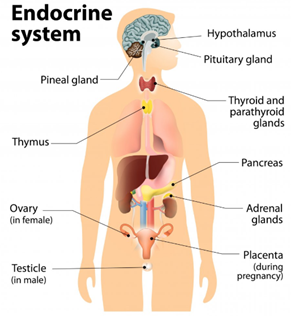
- Insulin’s discovery revolutionized diabetes treatment, turning a once fatal condition into a manageable one.
- Endocrine glands release hormones in minute quantities (10⁻⁹ to 10⁻¹² grams) to regulate body functions.
- The endocrine system operates without anatomical networks, unlike the nervous system.
- The pancreas serves both endocrine and exocrine roles, crucial in regulating blood sugar via insulin.
- Type 1 Diabetes Mellitus (T1DM): Autoimmune destruction of pancreatic insulin-producing beta cells. Affects 9 million people globally, with an incidence rate in India of 4.9 per 1,00,000 annually (PIB, 2022). Suspected causes include genetic and environmental factors, such as viral infections.
- Researchers isolated insulin from islets of Langerhans using experiments on dogs in 1921.
- First Injection (1922): A diabetic patient received insulin, marking a milestone in medicine. Refined extraction methods removed toxic impurities, ensuring safety and efficacy for human use.
- Discovery was awarded the Nobel Prize in Physiology or Medicine in 1923.
- Recombinant DNA Technology (1980s): Enabled large-scale production of human insulin by inserting insulin genes into bacteria.
| Important Glands of the Human Body Pituitary Gland: Master gland controlling other glands; regulates growth, metabolism, and reproduction via hormones like growth hormone and oxytocin. Thyroid Gland: Produces thyroxine; regulates metabolism, energy, and calcium balance; critical for growth and brain development in children. Adrenal Glands: Located above the kidneys; secrete cortisol and adrenaline to manage stress, metabolism, immune response, and blood pressure. Pancreas: Dual-role gland; produces insulin and glucagon to regulate blood sugar levels, and digestive enzymes for food breakdown. Pineal Gland: Secretes melatonin; regulates sleep-wake cycles, biological rhythms, and seasonal functions. Parathyroid Glands: Four small glands; regulate calcium and phosphate levels in blood, aiding bone health and neuromuscular function. Hypothalamus: Links nervous and endocrine systems; controls body temperature, hunger, thirst, sleep, and pituitary gland activities. Ovaries: Female reproductive glands; produce estrogen and progesterone, regulating menstrual cycles, pregnancy, and secondary sexual characteristics. Testes: Male reproductive glands; produce testosterone, responsible for sperm production and the development of secondary sexual characteristics. Thymus: Vital in early life; produces thymosin, aiding T-cell development for adaptive immunity. Shrinks after puberty. |
Dig Deeper: Read about the difference between Endocrine and Exocrine Glands.

